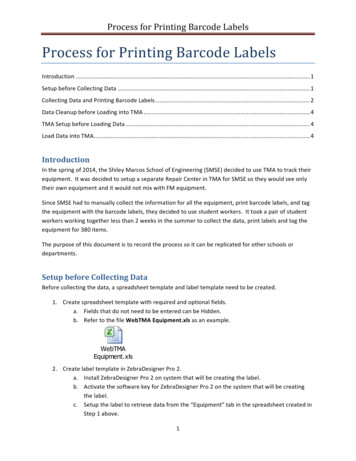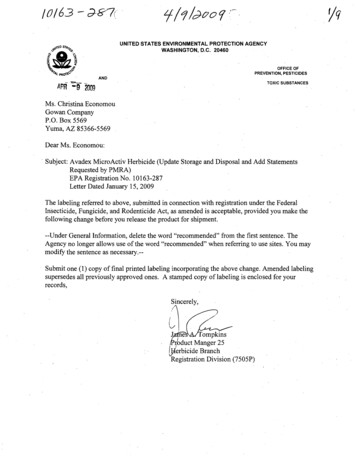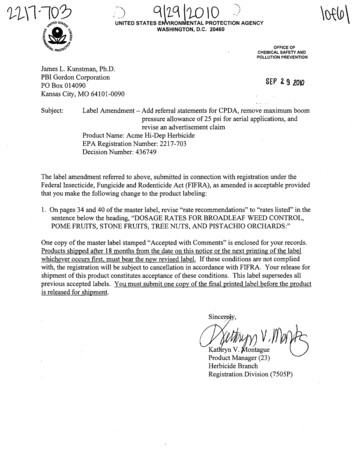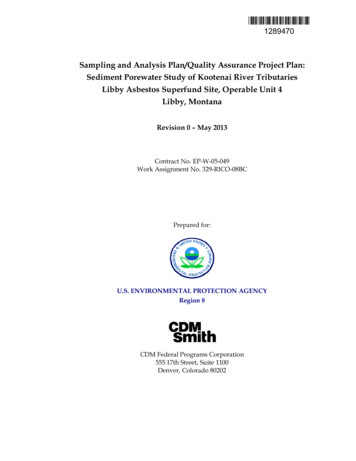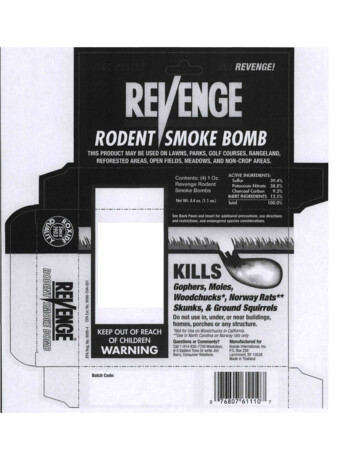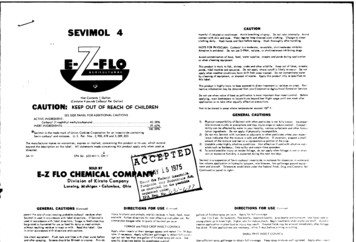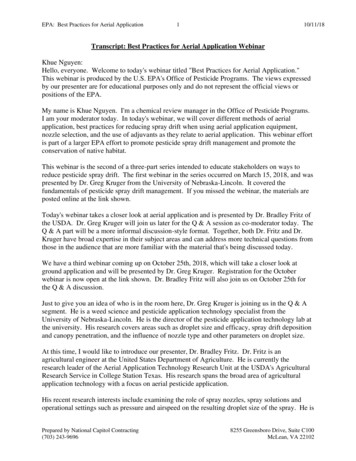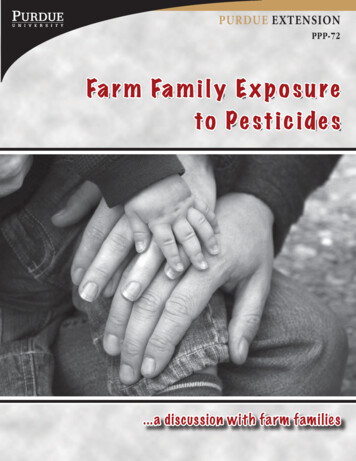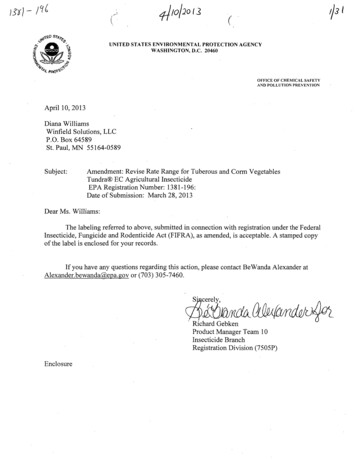
Transcription
2ol2//?/UNITED STATES ENVIRONMENTAL PROTECTION AGENCYWASHINGTON, D.C. 20460OFFICE OF CHEMICAL SAFETYAND POLLUTION PREVENTIONApril 10, 2013Diana WilliamsWinfield Solutions, LLCP.O. Box 64589St. Paul, MN 55164-0589Subject:Amendment: Revise Rate Range for Tuberous and Corm VegetablesTundra EC Agricultural InsecticideEPA Registration Number: 1381-196:Date of Submission: March 28, 2013Dear Ms. Williams:The labeling referred to above, submitted in connection with registration under the FederalInsecticide, Fungicide and Rodenticide Act (FIFRA), as amended, is acceptable. A stamped copyof the label is enclosed for your records.If you have any questions regarding this action, please contact BeWanda Alexander atAlexander.bewanda@epa.gov or (703) 305-7460.Richard GebkenProduct Manager Team 10Insecticide BranchRegistration Division (7505P)Enclosure
rRESTRICTED USE PESTICIDEToxic to fish and aquatic organisms. For retail sale to and use only by certifiedapplicators, or persons under their direct supervision and only for the uses covered by thecertified applicator's certification.Tundra ECAgricultural InsecticideActive Ingredient:By Wt.Bifenthrin* (2 methyl[1,1'-biphenyl]-3-yl) methyl lcyclopropanecarboxylate25.1%Inert Ingredients**:74.9%TOTAL100.0%*Cis isomers 97% minimum, trans isomers 3% maximum. "Contains xylene range aromatic solventsThis product contains 2 pounds active ingredient per gallon.KEEP OUT OF REACH OF CHILDRENWARNINGAVISOSi usted no entiende la etiqueta, busque a alguien para que se la explique a usted en detalle. (If you do notunderstand the label, find someone to explain it to you in detail.)This label must be in the possession of the user at the time of application.FIRST AIDIf swallowedImmediately call a poison control center or doctor.Do not induce vomiting unless told to do so by the poison control center or doctor.Do not give any liquid to the person.Do not give anything by mouth to an unconscious person.If in eyesHold eye open and rinse slowly and gently with water for 15-20 minutes.Remove contact lenses, if present, after the first 5 minutes, then continue rinsing eye.Call a poison control center or doctor for treatment advice.If inhaledMove person to fresh air.If person is not breathing, call 91 1 or an ambulance, then give artificial respiration,preferably by mouth-to-mouth, if possible.Call a poison control center or doctor for further treatment advice.If on skin orTake off contaminated clothing.clothingRinse skin immediately with plenty of water for 15-20 minutes.Call a poison control center or doctor for treatment advice.NOTE TO PHYSICIANThis product is a pyrethroid. If large amounts have been ingested, the stomach and intestine should beevacuated. Treatment is symptomatic and supportive. Digestible fats, oils, or alcohol may increaseabsorption and so should be avoided. Contains petroleum distillates. Vomiting may cause aspirationpneumonia.,, f .Have the product container or label with you when calling a poison control center or doctor, or going fortreatment. For Medical Emergency Assistance Call 1-877-424-7452.c 'c; c i t i i*. tILEPA Reg. No. 1381-196AManufactured for:Winfield SolutionsP.O. Box 64589St. Paul, MN 55164-0589EPAEst.cM pM5305-GA-'1 (PD sfT* IISPSnPi LW n\* 1?J&vlet Contents 2.5 Gal&.t (sUe Lite/sJ c ,1/032(3 0 c i!mu-J rFungicide, and Rodenticlde Act, - -* "'t. 5Ln rfed, for the pesticide1t t I t.fLL-ti. .(.(.(.(.(t.lAfntiETiPi rv(C
rPRECAUTIONARY STATEMENTSHazards to Humans and Domestic AnimalsWARNINGAVISOWARNING. May be fatal if swallowed. Harmful if inhaled, or absorbed through skin. Causesmoderate eye irritation. Avoid breathing vapor or spray mist. Avoid contact with skin, eyes, orclothing.Personal Protective Equipment (PPE):Some materials that are chemical-resistant to this product are listed below. If you want moreoptions, follow the instructions for category E on an EPA chemical resistance category selectionchart.Handlers who may be exposed to the dilute through application or other tasks must wear: Long-sleeved shirt and long pants Chemical-resistant gloves such as barrier laminate, nitrile rubber, neoprenerubber or Viton Shoes plus socksHandlers who may be exposed to the concentrate through mixing, loading, application or othertasks must wear: Long-sleeved shirt and long pants Chemical-resistant gloves such as barrier laminate, nitrile rubber, neoprenerubber, or Viton Shoes plus socks Protective eyewearDiscard clothing and other absorbent materials that have been drenched or heavily contaminatedwith this product's concentrate. Do not reuse them. Follow manufacturer's instructions forcleaning/maintaining PPE. If no such instructions are present for washables, use detergent andhot water. Keep and wash PPE separately from other laundry.USER SAFETY RECOMMENDATIONSUsers should:Wash hands before eating, drinking, chewing gum, using tobacco, or using the toilet.Remove clothing immediately if drenched or if pesticide gets inside. Then wash thoroughly andcput on clean clothing.'c'CULCEnvironmental Hazardscctc"This pesticide is extremely toxic to fish and aquatic invertebrates. Use with care; whert applying "inareas adjacent to any body of water. Do not apply directly to water, to areas where iS-iirface wateris present or to intertidal areas below the mean high water mark. Do not make applications whenweather conditions favor drift from treated areas. Drift and run-off from treated areaVmay bo i [hazardous to aquatic organisms in neighboring areas. Do not contaminate wateVwrlen disposingof equipment washwaters. . . - . . (C (. C C tThis product is highly toxic to bees exposed to direct treatment or residues on blooming crops orweeds. Do not apply this product or allow it to drift to blooming crops or weeds while bees are1 tactively visiting the treatment area."cThe use of bifenthrin is prohibited in areas that may result in exposure of endangered species tobifenthrin. Prior to use in a particular county contact the local extension service for proceduresand precautions to use to protect endangered species.
fPhysical/Chemical HazardsDo not use or store near heat or open flame.DIRECTIONS FOR USEIt is a violation of Federal Law to use this product in a manner inconsistent with its labeling.Do not apply this product in a way that will contact workers or other persons, either directly orthrough drift. Only protected handlers may be in the area during application. For anyrequirements specific to your State or Tribe, consult the agency responsible for pesticideregulation.Resistance: Some insects are known to develop resistance to products used repeatedly forcontrol. Because the development of resistance cannot be predicted, the use of this productshould conform to resistance management strategies established for the use area. Consult yourlocal or state agricultural authorities for details.If resistance to this product develops in your area, this product, or other products with a similarmode of action, may not provide adequate control. If poor performance cannot be attributed toimproper application or extreme weather conditions, a resistant strain of insect may be present. 11you experience difficulty with control and resistance is a reasonable cause, immediately consultyour local company representative or agricultural advisor for the best alternative method ofcontrol in your area.AGRICULTURAL USE REQUIREMENTSUse this product only in accordance with its labeling and with the Worker Protection Standard 40CFR part 170. This Standard contains requirements for the protection of agricultural workers onfarms, forests, nurseries, and greenhouses, and handlers of agricultural pesticides. It containsrequirements for training, decontamination, notification, and emergency assistance. It alsocontains specific instructions and exceptions pertaining to the statements on this label aboutpersonal protective equipment (PPE), and restricted-entry interval. The requirements in this boxonly apply to uses of this product that are covered by the Worker Protection Standard.Do not enter or allow worker entry into treated areas during restricted-entry interval (REI) of 12hours.PPE required for early entry to treated areas that is permitted under the Worker ProtectionStandard and that involves contact with anything that has been treated, such as plants, soil, orwater, is: coveralls; chemical-resistant gloves, such as barrier laminate or nitrite rubber ort [neoprene rubber or Viton; and shoes plus socks.'
fSTORAGE AND DISPOSALPesticide StorageKeep out of reach of children and animals. Store in original containers only. Store in a cool,dry place and avoid excess heat. Carefully open containers. After partial use, replace lidsand close tightly. Do not put concentrate or dilute material into food or drink containers. Donot contaminate other pesticides, fertilizers, water, food, or feed by storage or disposal. Donot freeze or store below 40 F. If crystals are observed, warm material to above 60 F byplacing container in warm location. Shake or roll container periodically to redissolve solids.SpillsIn case of spill, avoid contact, isolate area and keep out animals and unprotected persons.Confine spills. To confine spill: If liquid, dike surrounding area or absorb with sand, cat litteror commercial clay. If dry material, cover to prevent dispersal. Place damaged package andused absorbent material in a holding container. Identify contents.Pesticide DisposalPesticide wastes are toxic. Improper disposal of excess pesticide, spray mixture, or rinsate isa violation of Federal Law. If these wastes cannot be disposed of by use according to labelinstructions, contact your State pesticide or environmental control agency, or the HazardousWaste representative of the nearest EPA Regional Office for guidance.Container Disposal: Use label language appropriate for container size and type.Nonrefillable containers. Do not reuse or refill this container. Clean container promptly afteremptying.Nonrefillable container equal to or less than 5 gallons. Triple rinse as follows: Empty theremaining contents into application equipment or a mix tank and drain for 10 seconds after theflow begins to drip. Fill the container % full with water and recap. Shake for 10 seconds. Pourrinsate into application equipment or a mix tank or store rinsate for later use or disposal. Drain for10 seconds after the flow begins to drip. Repeat this procedure two more times. Then offer forrecycling or reconditioning, or puncture and dispose of in a sanitary landfill, or by otherprocedures approved by State and local authorities. Do not cut or weld metal containers.Nonrefillable container greater than 5 gallons. Triple rinse as follows: Empty the remainingcontents into application equipment or a mix tank. Fill the container % full with water. Replaceand tighten closures. Tip container on its side and roll it back and forth, ensuring at least onecomplete revolution, for 30 seconds. Stand the container on its end and tip it back and forthseveral times. Turn the container over onto its other end and tip it back and forth several times.Empty the rinsate into application equipment or a mix tank or store rinsate for later use ofc Idisposal. Repeat this procedure two more times. Then offer for recycling or reconditioning, or cpuncture and dispose of in a sanitary landfill, or by other procedures approved by State and localcauthorities. Do not cut or weld metal containers.ctccccRefillable container. Refill this container with pesticide only. Do not reuse this container for any other purpose. Cleaning the container before final disposal is the responsibility of tire- parson disposing of the container. Cleaning before refilling is the responsibility of the refillei-.L T'o clean, ,,lthe container before final disposal, empty the remaining contents from this contair rj.nt.oc t ' application equipment or mix tank. Fill the container about 10 percent full with watef. Agitatetvigorously or recirculate water with the pump for 2 minutes. Pour or pump rinsate'i'riio'applicationequipment or rinsate collection system. Repeat this rinsing procedure two more times. Then tc c coffer for recycling or reconditioning, or puncture and dispose of in a sanitary landfill, or by other-c cprocedures approved by State and local authorities. Do not cut or weld metal containers. 'U-Turn Container: Do not rinse container. Do not empty remaining formulated product. Do notbreak seals. Return intact to point of purchase.FOR CHEMICAL EMERGENCY: Spill, leak, fire, exposure, or accident, callCHEMTREC 1-800-424-9300
Application InstructionsRate of application is variable according to pest pressure, timing of sprays, and field scouting.Use lower rates under light to moderate infestations; higher rates under heavy insect pressureand for mite control. Arid climates generally require higher rates.Cultivation within 10 feet of a water body is prohibited to allow for the growth of a vegetated filterstrip.In New York State this product may not be applied within 100 feet (using ground equipment) to300 feet (using aerial equipment) of coastal marshes or streams that drain into coastal marshes.Chemigation Use DirectionsApply this product only through sprinkler including center pivot, lateral move, end tow, side(wheel) roll, traveler, big gun, solid set, or hand move irrigation systems. Do not apply thisproduct through any other type of irrigation system. Do not connect an irrigation system(including greenhouse systems) used for pesticide application to a public water system.For LEPA irrigation a minimum of 0.75 inch of water per acre is recommended. Where nonemulsified oils are used as the diluent, 1 to 2 pints per acre is recommended.Results from utilizing chemigation have been variable and depend upon the set up and calibrationof equipment. Crop injury, lack of effectiveness, or illegal residues in the crop can result fromnon-uniform distribution of treated water. Contact your State Agricultural Extension Servicespecialists, equipment manufacturers or other experts for consultation on the suitability of theequipment set up to obtain effective control of the target insect pests.A person knowledgeable of the chemigation system and responsible for its operations, or underthe supervision of the responsible person, shall shut the system down and make necessaryadjustments should the need arise. Failure to cease application during a mechanical stoppagemay result in undesirable residues to adjacent areas.The system must contain a functional check valve, vacuum relief valve, and low pressure drainappropriately located on the irrigation pipeline to prevent water source contamination frombackflow.cThe pesticide injection pipeline must contain a functional, automatic, quick-closing check valve to-Lprevent the flow of fluid back toward the injection pump.'c " CCCC C tC '.CCCLCThe pesticide injection pipeline must also contain a functional, normally closed, solenbid-operateolvalve located on the intake side of the injection pump and connected to the system jr,te;1ock to c [ prevent fluid from being withdrawn from the supply tank when the irrigation system is either L 11,automatically or manually shut down.tc.cc.c\L L ' itiitf:cThe system must contain functional interlocking controls to automatically shut off *the pesticidecinjection pump when the water pump motor stops.if-ILt. (The irrigation line or water pump must include a functional pressure switch which will stop theLl 'lwater pump motor when the water pressure decreases to the point where pesticide distribution isadversely affected.
cSystems must use a metering pump, such as a positive displacement injection pump (e.g.diaphragm pump) effectively designed and constructed of materials that are compatible withpesticides and capable of being fitted with a system interlock.Do not apply when wind speed favors drift beyond the area intended for treatment.Tundra insecticide should be applied continuously for the duration of the water application.Tundra insecticide should be diluted in sufficient volume to ensure accurate application over thearea to be treated. When using chemigation, a minimum of 0.5 inch per acre of irrigation water isrecommended. Agitation generally is not required when a suitable diluent is used. A diluent testshould be conducted to ensure that phase separation will not occur during dilution andapplication. Failure to achieve a uniform dilution throughout the time of application may result inundesirable residues or less than desirable control.BUFFER ZONESVegetative Buffer StripConstruct and maintain a minimum 10-foot-wide vegetative filter strip of grass or otherpermanent vegetation between the field edge and down gradient aquatic habitat (such as,but not limited to, lakes; reservoirs; rivers; permanent streams; marshes or natural ponds;estuaries; and commercial fish farm ponds).Only apply products containing Bifenthrin onto fields where a maintained vegetative,buffer strip of at least 10 feet exists between the field and down gradient aquatic habitat.For guidance, refer to the following publication for information on constructing andmaintaining effective buffers:Conservation Buffers to Reduce Pesticide Losses. Natural Resources ConservationServices. USDA NRCS. 2000 Fort Worth, Texas. 21 pp.www. in. nrcs. usda.gov/technical/agronomy/newconbuf.pdfBuffer Zone for Ground Application (groundboom, overhead chemigation, orairblast)Do not apply within 25 feet of aquatic habitats (such as, but not limited to, lakes,reservoirs, rivers, permanent streams, marshes, natural ponds, estuaries, and commercialfish ponds).Buffer Zone for ULV Aerial ApplicationDo not apply within 450 feet of aquatic habitats (such as, but not limited to, lakes,reservoirs, rivers, permanent streams, marshes, natural ponds, estuaries, and commercialfish ponds).Buffer Zone for Non-ULV Aerial ApplicationDo not apply within 150 feet of aquatic habitats (such as, but not limited to, lakes,reservoirs, rivers, permanent streams, marshes, natural ponds, estuaries, and commercialfish ponds)Ill
rrSpray Drift RequirementsWind Direction and Speed\Only apply this product if the wind direction favors on-target deposition.Do not apply when the wind velocity exceeds 15 mph.Temperature InversionDo not make aerial or ground applications into temperature inversions.Inversions are characterized by stable air and increasing temperatures with height abovethe ground. Mist or fog may indicate the presence of an inversion in humid areas. Theapplicator may detect the presence of an inversion by producing smoke and observing asmoke layer near the ground surface.Droplet SizeUse only Medium or coarser spray nozzles' (for ground and non-ULV aerial application)according to ASAE (S572) definition for standard nozzles. In conditions of low humidityand high temperatures, applicators should use a coarser droplet size.Additional Requirements for Ground ApplicationsWind speed must be measured adjacent to the application site on the upwind side,immediately prior to application.For ground boom applications, apply using a nozzle height of no more than 4 feet abovethe ground or crop canopy.For airblast applications, turn off outward pointing nozzles at row ends and whenspraying the outer two rows. To minimize spray loss over the top in orchard applications,spray must be directed into the canopy.Additional Requirements for Aerial ApplicationsThe spray boom should be mounted on the aircraft as to minimize drift caused by wingtipor rotor vortices. The minimum practical boom length should be used and must notexceed 75% of the wing span or 80% rotor diameter.Flight speed and nozzle orientation must be considered in determining droplet size.Spray must be released at the lowest height consistent with pest control and flight safety.Do not release spray at a height greater than 10 feet above the crop canopy unless agreater height is required for aircraft safety.
rWhen applications are made with a cross-wind, the swath will be displaced downwind.The applicator must compensate for this displacement at the downwind edge of theapplication area by adjusting the path of the aircraft upwind.Rotational CropsCrops for which bifenthrin tolerances exist, may be rotated at any time. All other crops may berotated 30 days following the final application of bifenthrin.Tank-MixturesTundra insecticide may be applied in tank mixtures with other products approved for use onregistered crops. Observe all restrictions and precautions which appear on the labels of theseproducts. Test for compatibility of products before mixing.ARTICHOKESApply as directed in the following table at a rate of 6.4 fl. oz. per acre (0.1 Ib ai per acre).REMARKS AND RESTRICTIONSPESTApply when pest population reaches damaging threshold and repeat as necessaryartichoke plume moth,to maintain control, but not more often than 15 day intervals.cribrate weevilApplication by ground: Apply a full cover spray in a minimum of 75 gallons offinished spray per acre.Application by air: Apply specified rate in a minimum of 10 gallons per acre.Do not exceed 0.5 Ib ai per acre per season.A 5-day preharvest interval must be observed.
rBRASSICA CROPSApply as directed in the following table at rates indicatedRATE/ PESTCROPREMARKS AND RESTRICTIONSPests:Apply in a minimum of 2 gallons of finished spray perhead and stembrassica vegetablesaphids, armyworms, cornacre by air or in a minimum of 10 gallons per acre withincluding: broccoli,earworm, crickets,ground equipment. When applying by air, 1-2 quarts ofcucumber beetles,emulsified oil may be substituted for 1-2 quarts of waterBrussels sprouts,cabbage, cauliflower, cutworms, diamondback,in the finished spray. Thorough coverage is essential tomoth, flea beetles, groundachieve control.cavalo broccolo,beetles, importedDo not apply more than 0.5 Ib ai (1 quart) per acre perChinese broccoli (gaicabbageworm, leafhoppers, season.Ion, white floweringloopers, saltmarshDo not make more than 5 applications after bloom.broccoli, Chinesecaterpillar, stink bugs,Do not make applications less than 7 days apart.cabbage (napa),thrips, tobacco budworm,Do not apply within 7 days of harvest.Chinese mustardwhitefly, wireworm (adults)cabbage (gai choy)Rate: 2.1 to 6.4 fl. oz. perkohlrabiacre (0.033 to 0.1 Ib ai peracre).Pests:Banks grass mite, carminemite, lygus bugs, Pacificspider mite, twospottedspider miteRate: 5.12 to 6.4 fl. oz. peracre (0.08 to 0.1 Ib ai peracre).
10CANEBERRIESApply as directed in the following table at rates indicated.REMARKS AND RESTRICTIONSRATE/ PESTCROPApply by air or ground equipment using sufficientPests:bingleberries,leafrollers, orange tortrix, rootwater to obtain full coverage of foliage (minimum ofblackberries,10 gallons per acre by air and 50 gallons per acre byweevilsdewberries,Rate: 3.2 to 6.4 fl. oz. perground).loganberries,acre (0.05 to 0.1 Ib ai perOne application may be made pre-bloom and alowberries,second application may be made post bloom. Do notmarionberries,acre).olallieberries,exceed 0.2 Ib ai per acre per season. Do not applywithin 3 days of harvest.raspberries,Pests:For Crown Borer, apply 0.1 Ib ai /a, post-harvest (fall)youngberriesRaspberry crown boreror pre-bloom (spring), as a drench applicationspider mitesdirected at the crown of plants in a minimum of 200Rate: 6.4 fl. oz. per acre (0.1gallons water/acre. Greater efficacy is observed atIb ai per acre).higher water gallonages (up to 400 gallons/a) or in anapplication prior to a significant rainfall event. Do notmake both pre-bloom foliar and pre-bloom drenchapplications.CANOLA, CRAMBE, RAPESEEDApply as directed in the following table at a rate of 2.1 to 2.6 fl. oz. per acre (0.033 to 0.04 Ib aiper acre).REMARKS AND RESTRICTIONSPESTApply in a minimum of 2 gallons of finished spray per acre by air or in a minimumaphidsof 10 gallons per acre with ground equipment. When applying by air, 1-2 quartsarmywormscutwormsof emulsified oil may be substituted for 1-2 quarts of water in the finished spray.diamondback mothThorough coverage is essential to achieve control.Do not apply more than 0.08 Ib. a.i. (5.12 ounces formulated product) per acreflea beetleper season. Do not make applications less than 14 days apart.flea hoppergrasshopperDo not apply within 35 days of harvest.loopersother lepidopterous larvaeplant bugseed pod weevilstink bugsthripswhitefly
CITRUS (1 day phi)PestDiaprepes RootWeevil(Diaprepesabbreviatus)Rate16-32 fluidounces(.2S-.5 Ibactive) peracreSouthern BlueGreen RootWeevil(Pachnaeus litus)Blue GreenCitrus RootWeevil(Pachnaeusopalus)Brown leafNotcher(Epicarusmexicanus)Little LeafNotcher (Artipusfloridanus)Fireant(solenopsis spp.)Asian Cockroach(blattellaasahinae)6.4-16 fluidounces(0.1-.25 Ibactive) peracre.REMARKS AND RESTRICTIONSApply Tundra by ground equipment to bare soil beneath citrus trees. Tundra must beuniformly applied from the trunk to the drip line of tree; apply in a minimum of 40gallons of dilute spray per acre. Greater spray volume should insure greater uniformityof coverage. A pre- and post-application irrigation may aid in the uniformity ofcoverage as well. Tundra protects citrus tree roots from Diaprepes and other citrus rootweevil feeding by forming a barrier which provides contact activity on newly hatchedlarvae (neonates). As citrus root weevil eggs hatch in new foliage, neonates fall to the soilsurface beneath the tree and come in contact with Tundra as they attempt to burrow intothe root zone. Disturbance of the soil beneath trees should be minimized. Timing of Tundraapplications is critical. Current information suggests that peak emergence of adultDiaprepes Weevil varies by citrus growing region and these emergence peaks can bedramatically affected by environmental factors, such as soil moisture. Typically,two peaks are observed for Diaprepes, first in spring then late summer or early fall.Southern Blue-Green and Blue-Green Citrus Weevils and Fuller Rose Beetle andLittle Leaf Notches typically exhibit a single emergence peak in the spring. Brown andLittle Leaf Notches typically exhibit three emergence peaks in spring, summer and fall.Since emergence varies seasonally and by location, timing of Tundra application can beaccurately forecast by observing adults. Adults are most active early morning and lateafternoon; numbers can be estimated by trapping throughout spring and summer(emergence periods). Egg laying will occur for 8 to 10 weeks following adult emergencefrom the soil; larval invasion of the soil will begin 2-3 weeks following adult emergence.It is critical to have the Tundra soil barrier in place prior to drop of the neonates. Tundra isone of several effective tools in an integrated pest management program for Citrus RootWeevils. Application of Tundra should be used in conjunction with good cultural practices,biological control of larvae and foliar control of adults. Consult local university extensionpersonnel for current information to protect citrus trees from Citrus Root Weevil andother pests.Apply to individual citrus resets, when not in solid planted rows, using hand-gun orshielded sprayer. Peak emergence of Diaprepes root weevil generally occurs in thespring. Depending on weather conditions, a minor emergence of Diaprepes root weevilmay also occur in the fall. If the citrus grove to be treated is in an area whereweather conditions are conducive to primary emergence occurring in the spring, 32 fluidounces formulated product should be used to obtain the longest residual managementof Diaprepes root weevil. If the citrus grove to be treated is in an area where weatherconditions will promote more than one peak of pest emergence, 16 fluid ouncesformulated product can be applied early season and 16 fluid ounces formulated productcan be applied later in the season.Do not apply through irrigation systems.Do not allow any application of Tundra to contact fruit or foliage.Do not apply more than a total of 32 fluid ounces of formulated product(0.5 Ib. a.i.) per acre per year.Apply the specified dosage in a minimum of 40 gallons of finished sprayper acre.Ground application only. Do not apply by air.Do not apply within 1 day of harvest.
12COTTONApply as directed in the following table at rates indicated.RATEREMARKS AND RESTRICTIONSPEST1.3 to 6.4 fl. oz. Tundra may be applied in water or refined vegetable oilEuropean corn borer(0.02 to 0.1 Ibsoybean (banded) thrips(soybean/cottonseed).ai) per acreApplication in Water: Apply in a minimum of 5 gallonstobacco thripsper acre with ground equipment or 1 gallon per acre by2.6-6.4 fl. oz.boll weevilaircraft. When applying by air, 1 quart of emulsified oil(0.04 to 0.1 Ibbollwormmay be substituted for one quart of water in the finishedai) per acrecabbage looperspray.cotton aphidULV Application: Apply the recommended rate ofcotton fleahopperTundra in refined vegetable oil in a minimum of 1 quart ofcotton leaf perforatorfinished spray per acre with aircraft calibrated to givecutwormsadequate coverage.fall armywormTo Control Boll Weevil: Apply Tundra at an interval of 3plant bugsto 4 days until pest numbers are reduced to acceptablesaltmarsh caterpillarlevels.southern garden leafhopperTo Control Mites and Aphids: Apply when pests firststink bugsappear. Repeat as necessary to maintain control. Highertobacco budwormrates will be required once a damaging threshold iswhiteflyestablished.yellow striped armywormDo not apply more than 0.5 Ib. ai per acre per season.3.8-6.4 fl. oz.beet armywormDo not make more than 1 0 synthetic pyrethroid(0.06 to 0.1 Ibcarmine spider miteapplications (of one product or combination of products) toai) per acrelygus Spp.a cotton crop in one growing season. Synthetic pyrethroidpink bollwormproducts include Ambush , Ammo , Asana XL,twospotted spider miteBaythroid , Capture , Danitol , Karate , Mustang , andScout X-TRA .Do not graze livestock in treated areas or cut treatedcrops
Tundra EC Agricultural Insecticide EPA Registration Number: 1381-196: Date of Submission: March 28, 2013 Dear Ms. Williams: The labeling referred to above, submitted in connection with registration under the Federal Insecticide, Fungicide and Rodenticide Act (FIFRA), as amended, is acceptable. A stamped copy of the label is enclosed for your .
